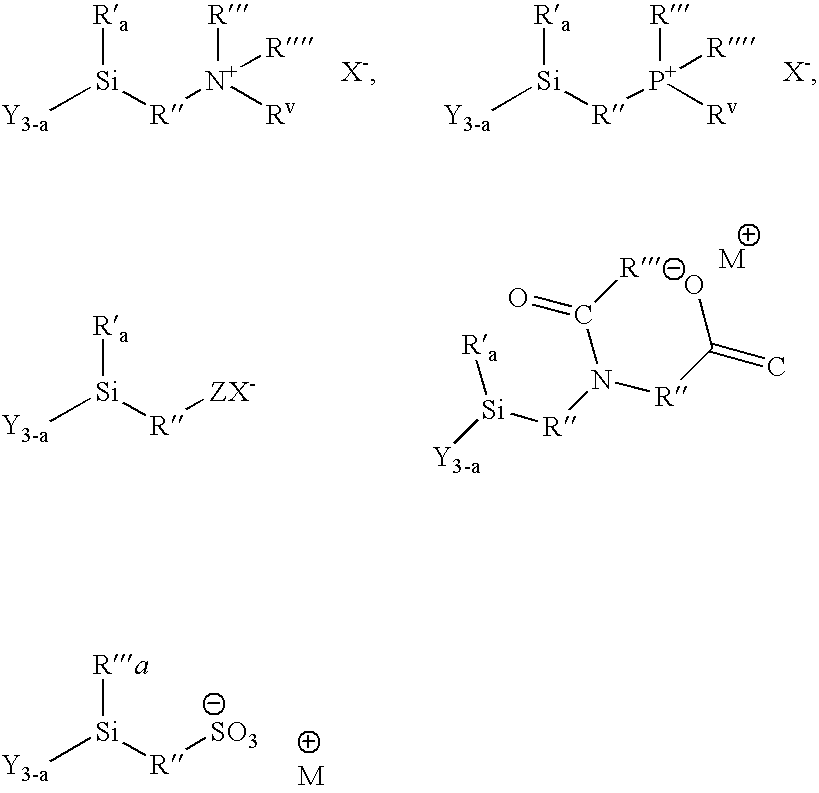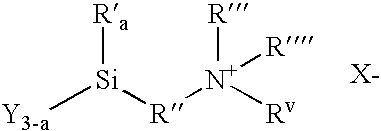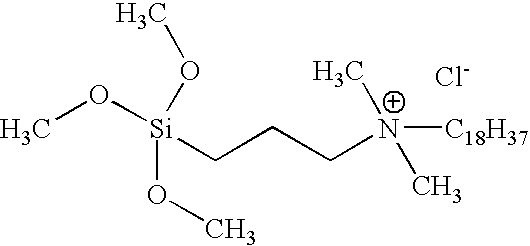Methods of treating surfaces with ionic organosilicon compositions
a technology of ionic organosilicon and composition, which is applied in the direction of superimposed coating process, liquid/solution decomposition chemical coating, manufacturing tools, etc., can solve the problems of lowering resistance, corrosion of reinforcing steel, damage to structures, etc., and achieve excellent hydrophobic properties
- Summary
- Abstract
- Description
- Claims
- Application Information
AI Technical Summary
Benefits of technology
Problems solved by technology
Method used
Image
Examples
example 1
3-[tri-(2-hydroxyethoxy)silyl]propyldimethyloctadecyl ammonium chloride
[0026]A two liter, three-necked flask equipped with a condenser, stirrer, thermometer and a distillation head, was charged with 360 grams (six moles) of ethylene glycol. To this solution, 200 grams of -3-chloropropyltrimethoxysilane was added drop-wise at 100° C. over a period of two hours. The mixture was heated for six hours at 100° C. during which time 101 grams of material, chiefly methanol boiling below 100° C., was recovered. 460 grams of a crude product mixture was obtained.
[0027]The major component of the crude product mixture was (OHCH2CH2O)3SiCH2CH(CH3)CH2Cl:
[0028][0029]3-chloropropyl-tri-(2-hydroxy-ethoxy) silane.
[0030]In the same reaction configuration, 265 grams (0.9 mole) of octadecyldimethylamine was added to the crude product solution. This mixture was heated to 120° C. for 20 hours. After 20 hours the reaction was complete. Titration of a sample of the product mixture showed the chloride ion conc...
example 2
[0034]A two liter, three-necked flask equipped with a condenser, stirrer, thermometer and a distillation head, was charged with 636 grams (six moles) of diethylene glycol. To this solution, 200 grams of -3-chloropropyltrimethoxysilane was added drop-wise at 100° C. over a period of two hours. The mixture was heated for six hours at 125° C. during which time 101 grams of material, chiefly methanol boiling below 100° C., was recovered. 735 grams of a crude product mixture was obtained.
[0035]The major component of the crude product mixture was (OHCH2CH2OCH2CH2O)3SiCH2CH(CH3)CH2Cl:
[0036]
[0037]In the same reaction configuration, 265 grams (0.9 mole) of octadecyldimethylamine was added to the crude product solution. This mixture was heated to 120° C. for 20 hours. After 20 hours the reaction was complete. Titration of a sample of the product mixture showed the chloride ion concentration to be 2.97%. The structure of the major component was (OHCH2CH2OCH2CH2O)3SiCH2CH2CH2N(CH3)2C18H37Cl—:
[0...
example 3
3-(trimethoxysilyl)-2-methylpropyldimethyloctadecyl ammonium chloride
[0040]A two liter, pressure reactor equipped with a stirrer, thermometer, was charged with 225 grams of -3-chloro-2-methylpropyl-trimethoxysilane (1.1 mole), 295 grams of dimethyloctadecylamine (1.0 mole) and 100 grams of methanol. The mixture was heated for 30 hours at 120° C. After 30 hours the reaction was complete. Titration of a sample of the product mixture showed the chloride ion concentration to be 5.62%. The structure of the major component was (CH3O)3SiCH2CH(CH3)CH2N(CH3)2C18H37Cl—:
[0041][0042]3-(trimethoxysilyl)-2-methylpropyldimethyloctadecyl ammonium chloride.
[0043]The calculated chloride ion concentration for the product mixture was 5.71%. The product was miscible with water in all proportions.
PUM
| Property | Measurement | Unit |
|---|---|---|
| weight percent | aaaaa | aaaaa |
| weight percent | aaaaa | aaaaa |
| weight percent | aaaaa | aaaaa |
Abstract
Description
Claims
Application Information
 Login to View More
Login to View More - R&D
- Intellectual Property
- Life Sciences
- Materials
- Tech Scout
- Unparalleled Data Quality
- Higher Quality Content
- 60% Fewer Hallucinations
Browse by: Latest US Patents, China's latest patents, Technical Efficacy Thesaurus, Application Domain, Technology Topic, Popular Technical Reports.
© 2025 PatSnap. All rights reserved.Legal|Privacy policy|Modern Slavery Act Transparency Statement|Sitemap|About US| Contact US: help@patsnap.com



